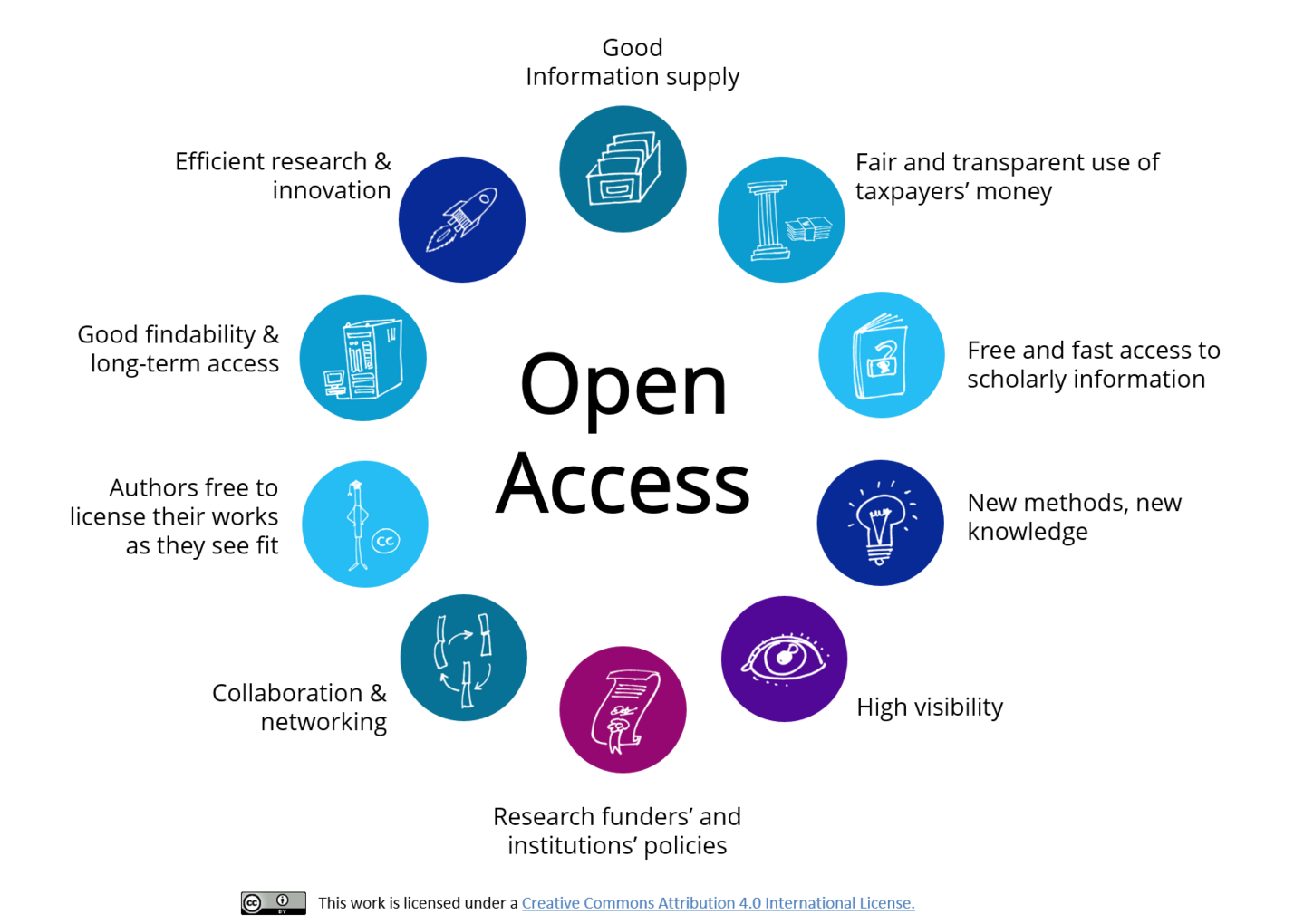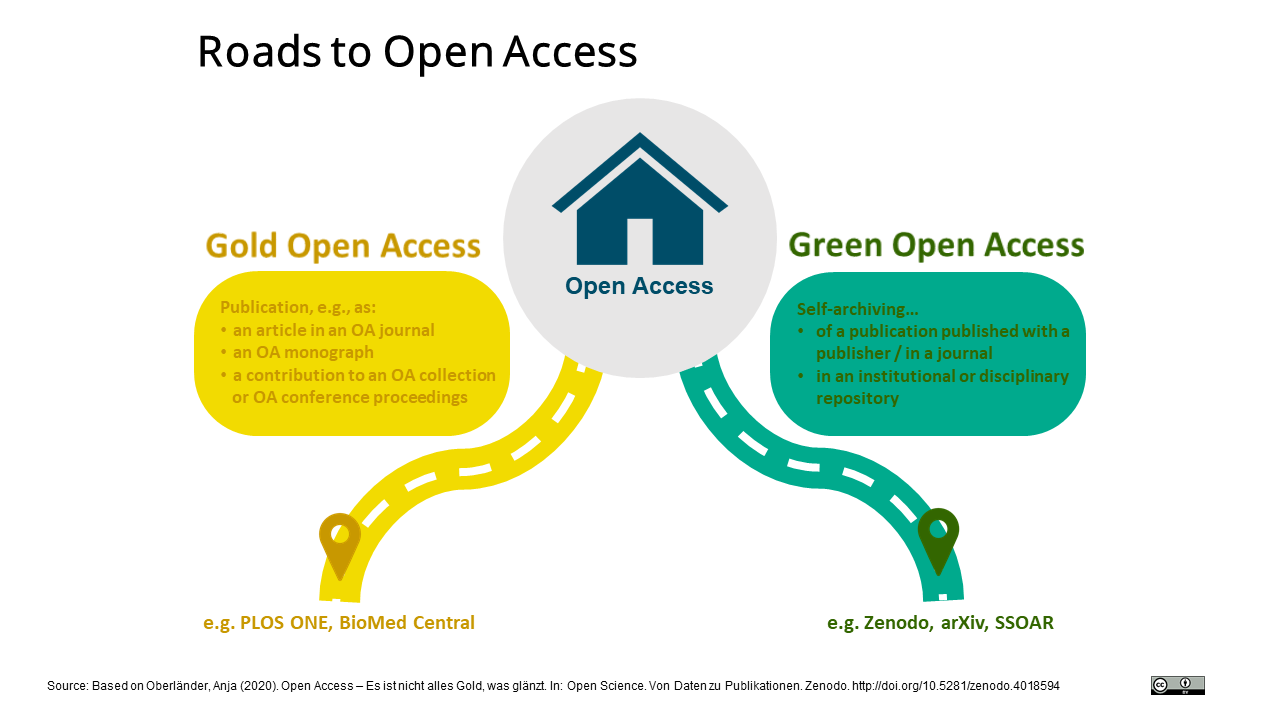Open Access in 60 seconds
Source: Brinken, Helene, Jonas Hauss, Jessika Rücknagel (2021). Open Access in 60 seconds, open-access.network. https://doi.org/10.5446/50832
Definition
In a nutshell: open access means free access to scholarly literature on the Internet. The most commonly invoked definition of open access comes from the so-called Budapest Declaration (2002).
Thus, the aim of open access is to make scholarly literature freely accessible and reusable for everyone – that is, free of charge and, as far as possible, free of technical and legal barriers. The Berlin Declaration on Open Access to Knowledge in the Sciences and Humanities (2003) requires that, to qualify as open access, a contribution must not only be usable free of charge, but also users must be permitted "to copy, use, distribute, transmit and display the work publicly and to make and distribute derivative works in any digital medium for any responsible purpose, subject to proper attribution." (Berlin Declaration on Open Access to Knowledge in the Sciences and Humanities, 2003).
"By open access to this literature, we mean its free availability on the public internet, permitting any users to read, download, copy, distribute, print, search, or link to the full texts of these articles, crawl them for indexing, pass them as data to software, or use them for any other lawful purpose, without financial, legal, or technical barriers other than those inseparable from gaining access to the internet itself. The only constraint on reproduction and distribution, and the only role for copyright in this domain, should be to give authors control over the integrity of their work and the right to be properly acknowledged and cited."
- Budapest Open Access Initiative Declaration, 2002; emphasis added

It is important to know that scholarly research is for the most part publicly funded. The results of this publicly funded research should therefore also be publicly accessible. Open access publications are immediately and easily accessible free of charge and reusable. This free and fast access to scientific findings expedites the scholarly communication process, thereby enhancing efficiency in research and innovation. This also fosters the international and interdisciplinary collaboration between and the networking of researchers. Open access significantly increases the citation frequency and thus also the visibility of research findings (Swan, 2010; Li et al., 2018). Another important factor is that, in the case of open access publications, authors retain their rights to exploit the works instead of assigning these rights exclusively to a publisher. Thus, an open access publication can be redistributed and reused easily by others.
Paths to Open Access
There are two basic strategies for implementing open access: green and gold. Gold open access refers to the publication of scholarly works as articles in open access journals, as open access monographs, or as contributions to open access collections or conference proceedings.
Green open access – also known as self-archiving – refers to making preprints or post-prints of works published with a publisher or in a journal available to the public by depositing them in a repository.

Video about the funding of open access articles
Video about the funding of open access monographs
Whereas open access publications are similar to conventional publications in many respects – for example, with regard to peer review – the big difference between them is the way they are funded. In the conventional publishing system, a publication benefits from public funds three times:
- As mentioned above, researchers are usually paid from public funds.
- During the publication process, works undergo quality assurance procedures, for example, peer review. Peer reviews are conducted by other researchers, who are not as a rule paid for doing so by the publishers or journals.
- And finally, libraries and institutes have to subscribe to the journals or purchase the books from the publishers in order to be able to make them available to their members.
By contrast, open access meets the demand to make the results of publicly funded research freely accessible for everyone. Researchers who work at institutions with more limited budgets also benefit from this, as do interested parties who are not affiliated with an institution. Because readers can use open access publications free of charge, these publications must be funded elsewhere. The so-called author-pays model, whereby authors pay article processing charges (APCs) or book processing charges (BPCs) for the publication of their works, is widely used. Many institutions now offer to pay these costs for their members, for example, via publication funds or participation in consortia. However, the majority of open access journals (over 70% of the journals indexed in the Directory of Open Access Journals, DOAJ) are free of charge both for readers and authors. These journals are financed, for example, via professional associations, academic institutions, or – in kind – by voluntary work (Morrison, 2018). Especially against the backdrop of the sometimes horrendous prices that conventional publishers charge for journal subscriptions, open access can make an important contribution to sustainably easing the pressure on strained library budgets, while at the same time considerably improving the literature supply.
Licensing
In addition to toll-free access to scholarly findings, the second key component of open access is their widest possible reuse. It is up to the authors themselves to decide what degree of freedom of use of their works they wish to allow. By granting usage licences, authors specify the rights that third parties have when using their research findings. The now widely used Creative Commons (CC) licences are well suited for this purpose. The use of the CC BY licence is particularly recommended. It grants everyone a free, worldwide right of access to the publication as well as the right to reuse it, for example, by copying, distributing, transmitting, publicly displaying, or adapting it. Those who reuse content must give appropriate credit to the author of the work. Note, however, that it is not possible for authors to grant open licences if they have already granted the rights of use in question exclusively to a publisher.
How exactly do Creative Commons licenses work?
Practical Tip
Scientists can actively support the change to open science through their own publishing behavior. This practical tip "Supporting Open Access" explains how.
Who Supports Open Access?
Open access is promoted and requested or demanded both by policymakers at European and national level (top down) and on the initiative of committed scholars and scientists, professional societies, infrastructure facilities, and publishers (bottom up). Thus, universities and research institutions have adopted open access policies in which they encourage their members to publish their works open access. Open access is also often enshrined as an obligation, or at least as a request, in the grant conditions of third-party funders. In a diverse landscape of open access journals, publishers, and repositories, most conventional scholarly publishers now offer open access models or are pursuing transformative aspirations.
Open Science
Open access is an element of much of what can be subsumed under the umbrella term open science (Watson, 2015). Following Neuschäfer (2015), open science bundles strategies and procedures that aim to make all elements of the scientific process openly accessible, transparent, and reusable. This means that not only scholarly publications should be freely available in accordance with the open access model but also, among other things, research data (through open access and research data management), research software, and teaching materials (through open educational resources, OER). An exact description of the elements of open science can be found on the German-language website openscienceASAP. Open science is based on the principles of transparency, reproducibility, reusability, and open communication (Open Science AG, n.d.). Thus, open science is an important element of ensuring good scientific practice.

References
- Berlin Declaration on Open Access to Knowledge in the Sciences and Humanities. (2003). https://openaccess.mpg.de/67605/berlin_declaration_engl.pdf Budapest Open Access Initiative. (2002).
- Budapest Open Access Initiative Declaration. (2002).
https://www.budapestopenaccessinitiative.org/read - Li, Y., Wu, C., Yan, E., & Li, K. (2018). Will open access increase journal CiteScores? An empirical investigation over multiple disciplines. PloS One, 13(8). https://doi.org/10.1371/journal.pone.0201885
- Morrison, H. (2018, January 31). DOAJ APC information as of Jan 31, 2018. Sustaining the Knowledge Commons / Soutenir Les Savoirs Communs. Open Access Scholarship / Littérature Savante En Libre Accès. https://sustainingknowledgecommons.org/2018/02/06/doaj-apc-information-as-of-jan-31-2018/
- Neuschäfer, M. (2015, November 18). Mission Statement der deutschsprachigen Open Science AG. Ag-OpenScience.De. https://ag-openscience.de/ag-mission-statement/
- Oberländer, A. (2020). Open Access – Es ist nicht alles Gold, was glänzt. In: Open Science. Von Daten zu Publikationen. Zenodo. http://doi.org/10.5281/zenodo.4018594
- Open Science AG. (n.d.). Open Science. https://ag-openscience.de/open-science/
- Swan, A. (2010). The Open Access citation advantage: Studies and results to date. https://eprints.soton.ac.uk/268516/
- Watson, M. (2015). When will ‘open science’ become simply ‘science’? Genome Biology, 16(1). https://doi.org/10.1186/s13059-015-0669-2
Weiterführende Literatur
- Suber, P. (2012). Open Access. The MIT Press. https://mitpress.mit.edu/books/open-access, Open Access unter https://archive.org/details/9780262517638OpenAccess